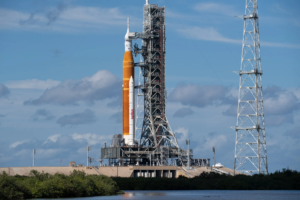
A Closer Look At SpaceX’s Unique Lunar Lander
Looking back in history the United States was responsible for putting the first men on the Moon. To do so they created one of the most powerful rockets in the world to carry their lunar module. This module was capable of carrying multiple astronauts and some additional equipment. The last time a lunar lander was used to put humans on the Moon was December 14th, 1972. New goals and opportunities have sparked a lot of interest in putting humans back on the Moon. With this has come a lot of new lunar lander designs by many companies. Today I want to highlight the Starship lunar lander being created by SpaceX. Its unique design and features make it stand out from all the current and past competition.
Why Is SpaceX Building A Moon Lunar Lander?
One of the main reasons SpaceX is building a lunar lander is because they won NASA’s competition. Currently, NASA is working on its Artemis mission. This mission consists of creating a Moon space station, Moonbase, and putting humans back on the surface. While NASA is working on the main rocket and other aspects they created a competition between some of the primary private space companies to create a lunar lander.
These companies included SpaceX, Dynetics, and the National Team consisting of Blue Origin, Lockheed Martin, Northrup Grumman, and Draper. After NASA looked at all the proposed options they ended up choosing SpaceX’s Starship lunar lander for multiple reasons. This pick granted SpaceX $2.9 billion which is going towards their lunar lander’s further development.
Specific Innovative Features

Size – One of the most obvious unique aspects of this lunar lander is the size. Coming in at 50m (164ft) tall, and 9m (30ft) wide it will be the largest lunar lander by far to ever land on the surface of the Moon. With this size comes some challenges but also a lot of benefits. One specific benefit is all the additional space. Astronauts will be transferred from the Orion capsule and get into the massive SpaceX lunar lander. All this additional space could help on future missions where they need to transfer a lot of supplies or humans from the Moon to Earth or the other way around.
Engines – Another very interesting part of the SpaceX lunar lander is the type and placement of engines. Just like a regular Starship, it will have three sea-level Raptor engines and three vacuum raptor engines on the bottom. These will be for leaving Earth’s atmosphere and traveling to the Moon. The big difference is the additional smaller engines high up on the Lunar Lander. As you can see on the mock-up image above they are planning to have a large quantity of smaller engines towards the top of the rocket.
These engines would be responsible for slowing the rocket down to a stop right before touching the surface. They also would be the initial engines used to get off the surface of the Moon. The reason for this is to avoid launching a lot of Moon rock up off the ground. If SpaceX were to light up their main raptors it would send massive amounts of material into the sky and could cause some damage. These smaller engines would be high enough to avoid launching Moon material but still slow the rocket down enough for a safe landing.
Reusability – SpaceX’s lunar lander ideally would also be fully reusable. SpaceX hates to use a rocket once just to trash most of it after one launch. Typically with past lunar landers and others in design, a large portion of the lander is left on the surface of the Moon after launch. The Starship lunar lander is just one section that is planned to land and take off in one piece. If SpaceX can figure out the fuel they will be able to continually use the same lunar lander and save a lot of money.
Cost – One last aspect of this lunar lander I want to point out is the cost. Just like the regular Starship rocket, it is meant to be very affordable. This is because of the materials it’s made out of and the reusability. SpaceX has been using a type of stainless steel for their Starship models instead of complex and expensive metal alloys often used by other companies. This helps them bring their cost down by quite a bit. You add the reusability aspect and you have a lunar lander that is very cheap to use consistently.
How It Compares To Other Lunar Landers

This lunar lander exceeds the competition in most aspects. This is the reason NASA choose it to win the $2.9 billion. When comparing it to other options like Dynetics or the National Team you can see some of the main differences. One of the deciding factors was current development. While the other companies had only made mock-ups SpaceX is currently testing their Starship rocket. This includes pressure tests, static fires, 150m hops, and even 10km launches. All of this testing made NASA more confident in their choice.
Another difference between SpaceX’s lunar lander and others is the cost and size. Despite SpaceX’s lander being so much larger, it still managed to cost quite a bit less than the other options. As NASA is on a tight budget this was a big factor when picking. In NASA’s official evaluation document they said “SpaceX’s Total Evaluated Price of $2,941,394,557 was the lowest among the offerors by a wide margin. Blue Origin’s Total Evaluated Price was significantly higher than this, followed by Dynetics’ Total Evaluated Price, which was significantly higher than Blue Origin’s.” If you want to read more about their decision check out the full document here.
How Far Is SpaceX On It’s Development?
Based on the fact that SpaceX’s lunar lander is a slight modification to their Starship rocket they are far into development. Currently, Starship has completed many tests and recently completed the first successful 10km flight. This flight was a huge milestone and is helping prove the capabilities of the rocket.
Even more important is the upcoming orbital test. This test will use the entire rocket including the main booster Super Heavy and will launch Starship into orbit. If this test is also successful it will mean their lunar lander is one step closer to becoming a real thing. In terms of progress on a physical exact lunar lander, they have only built a temporary nosecone. However the lunar lander and normal Starship model share so many similarities that progress for one means progress for the other.
Conclusion
It seems that whatever SpaceX starts to work on they create and innovate something very unique. It’s this type of engineering that will help make great strides for the future of the space industry. The SpaceX lunar lander is a perfect example of that. It looks nothing like any lunar lander from the past and its capabilities reflect that as well. Between the size, cost, engines, reusability, and more, there is no other lander like it. It’s these reasons why NASA picked it as the best option for their upcoming Artemis mission. It is likely the next time we watch human’s step foot on the Moon it will be from the SpaceX lunar lander.



